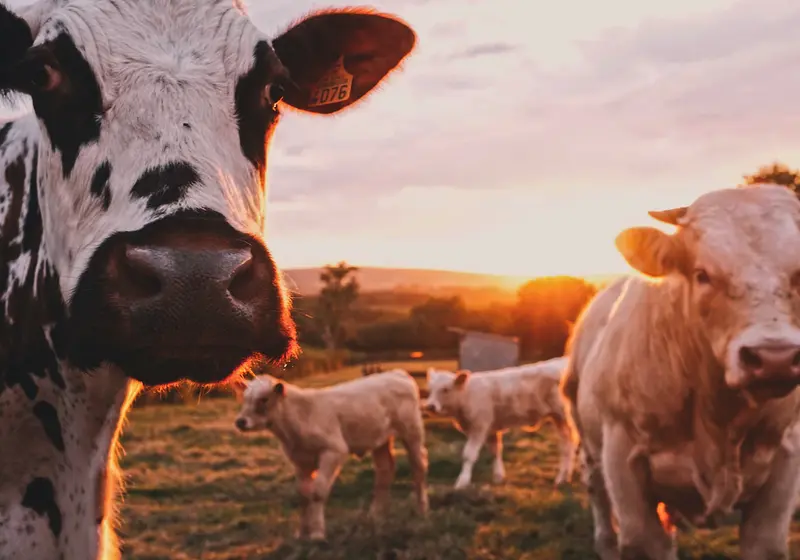Animal agriculture, or, the beef in your salad, innocuous as it seems, is responsible for 90 percent of global deforestation and 500 nitrogen-flooded ocean dead zones, threatening more than 5400 animal species into extinction. Despite all of its devastating destructions to the world’s ecosystem, the livestock industry only produces 18 percent of the world’s calories, still leaving a large portion underfed and undernourished. In order to halt humans from undermining the planet further, cell-cultured meat (meat differentiated through the cultivation of animal stem cells in laboratories) is thus proposed as an alternative protein, solution to impending problems and game-changer to the global meat industry. Yet, its practicality and drawbacks still fall under a question mark.

Image Credit: Spiske from Pexels
Let us slide into your dms 🥰
Get notified of top trending articles like this one every week! (we won't spam you)Meat of the Future: Potential Advantages
Firstly, cell grown meat could be the hero in combating climate change. Animal agriculture is at extreme unsustainability. Currently, the livestock sector accounts for up to 16.5 percent of global greenhouse gas emissions.
Animal farming, exhausting nearly a huge percentage of global farming land, also acts as the major contributor of biodiversity loss and water pollution. Yet cultivated under laboratory facilities, cell grown meat eliminates the involved and inefficient process of nurturing livestock, significantly reducing the level resource usage as well as agriculture-initiated pollution. Good Food Institute, a proponent of cultivated meat, confirms that application of renewable energy in cell grown meat could drop carbon footprints dramatically. In comparison with conventional beef, cultivated beef’s carbon footprint is a stunning 92 percent less. Beyond reducing carbon emissions, cell grown meat requires 90 percent less land and causes 94 percent less air pollution.
Besides decelerating the fast tides of global warming, cell-cultured meat can also increase accessibility to food. Along with the population boom, the demand for livestock protein is expected to increase by 13 percent before the end of this decade, while meat consumption has doubled globally over the past two decades. Yet chances are, if humans rely solely on animal agriculture, it will be difficult to rear enough livestock to feed the entire population of 7 billion in the coming years.
Hence, cell-cultured meat, with its ability to indefinitely renew sourced cells, can produce cultivated-meat indefinitely. It acts as a potential alternative to conventional meat, alleviating the burden from conventional supply chains.
Another advantage of cell-cultured meat is its key feature of being cruelty-free. Despite not being fully vegan, the extraction of animal cells does not require the slaughtering of animals. With more than 23.3 million land animals slaughtered per day under the blades of mechanical machines in the US, cell grown meat could also put an end to animal suffering, allowing meat its ethicality.


Take the Quiz: Which Squid Game Player Are You?
Ever wondered which player you’d be if you found yourself in the Squid Game universe? Take this quiz to find out which character matches your perso...
Viability of Cultivated Meat: Challenges and Limitations
Although cultivated meat may seem like the solution to climate change and world hunger, many obstacles may lie in the adoption process of cell-cultured meat. Despite all of its potential benefits, the practical question would be: can cultivated meat really reach the market?
First, there’s the issue of cost. The costs of bioreactors and the high-skilled workers are without a doubt high, and even under large-scale production, cultivated meat still costs approximately $17 per pound to create at minimum. This suggests the high unaffordability and low cost-effectiveness of cell-cultured meat, especially in comparison with conventional meat, in which a pound of beef would only cost $2.
Another issue lies in its safety. Many proponents of cell-cultured meat have claimed it perfectly safe due to its absence of antifungal agents and its cultivation under a controlled environment. Nonetheless, numerous hazards were still identified in the manufacturing process and final product of cell-cultured meat. First is the lack of key nutritional properties. Lab grown meat may not possess types of nutrition such as vitamin B1277, creatin, carnosine, vitamin D3, and iron. Second is the contamination and infections from components used in the process of cell-culturing. The Food Standards Agency writes that around 20 types of mycoplasma species (small, gram-negative bacteria), have been identified from cell culture due to contaminated reagents and poorly maintained equipment. Furthermore, more than 36% of cell lines have been shown to contain cross-contamination and misidentification issues. The manufacturing of cell-cultured meat is in need of further regulation in order to achieve a safe and contamination-free protein product.
Then comes the issue of consumer acceptability. The unnaturalness of lab-grown meat acts as a leading barrier to public acceptance. In a survey consisting 1587 volunteers, 35 percent of meat-eaters and 55 percent of vegans still refused to try out cultivated meat.
Denial to cell-cultured meat is especially notable in more senior citizens. In another survey of more than 1825 older citizens (65+), cultured meat was the least preferred alternative protein.
It would be difficult for cell-cultured meat to reach the market unless the issues above are addressed.

Image Credit: JÉSHOOTS from Pexels
Under the Mask of this “Utopian Meat”: Risks and Problems
While the practicality of cell-cultured meat still remains a mystery, its adoption also possesses a great deal of unintended consequences.
Cell-cultured meat could drastically reduce the demand for jobs in animal agriculture. The livestock sector globally employs 1.3 billion people, while more than 600 million small farmers depend entirely on livestock rearing for a livelihood. Even though cell-cultured meat will undoubtedly result in new employment, these positions may not be as accessible to present agricultural workers.
The cultivation of cell-cultured meat usually involves intricate processes, requiring high-level qualifications and education. However, taking Brazil as an example, it is shown that only 3 percent of those who work in raising pigs have a university degree, while 60 percent even failed to complete the first stage of education. Thus, a profound change in the global meat production chain would without a doubt lead to massive job losses and souring unemployment.
The global adoption of cell-cultured meat may also hurt the economies of countries. It could exacerbate dependence of developing countries on food imports from foreign labs. Over-reliance on foreign food exports would not only put these countries into food insecurity risks at times of restrictive export policies, but could also disrupt a nation’s balance of trade and devalue a country’ currency.

Image Credit: Boltneva from Pexels
Next Steps
The market value of global cultivated meat is expected to reach $25 billion by 2030. Looking forward, we know that cell-cultured meat has the potential to address impending global issues, from environmental impacts to world hunger. However, challenges and risks during the process of its adoption to the global market chain must be carefully addressed by governments.
Firstly, technological advancements must be made and regulatory standards must be set to ensure both the safety and price-competitiveness of cell-cultured meat, assisting it to achieve price parity with conventional meat. It is also vital for the more widespread acceptance from regulatory agencies, as to act as the first steps to public acceptance.
The USDA’s recent approval of lab-grown chicken, for instance, is paving the way for the development of this revolutionizing innovation. After its adoption, governments must work in collaboration to minimize its economic impacts of job loss and import dependence. It is only with strong regulations and governmental assistance can cell-cultured meat co-exist with conventional meat, playing the role of an alternative protein to improve the sustainability of food production and accessibility.














